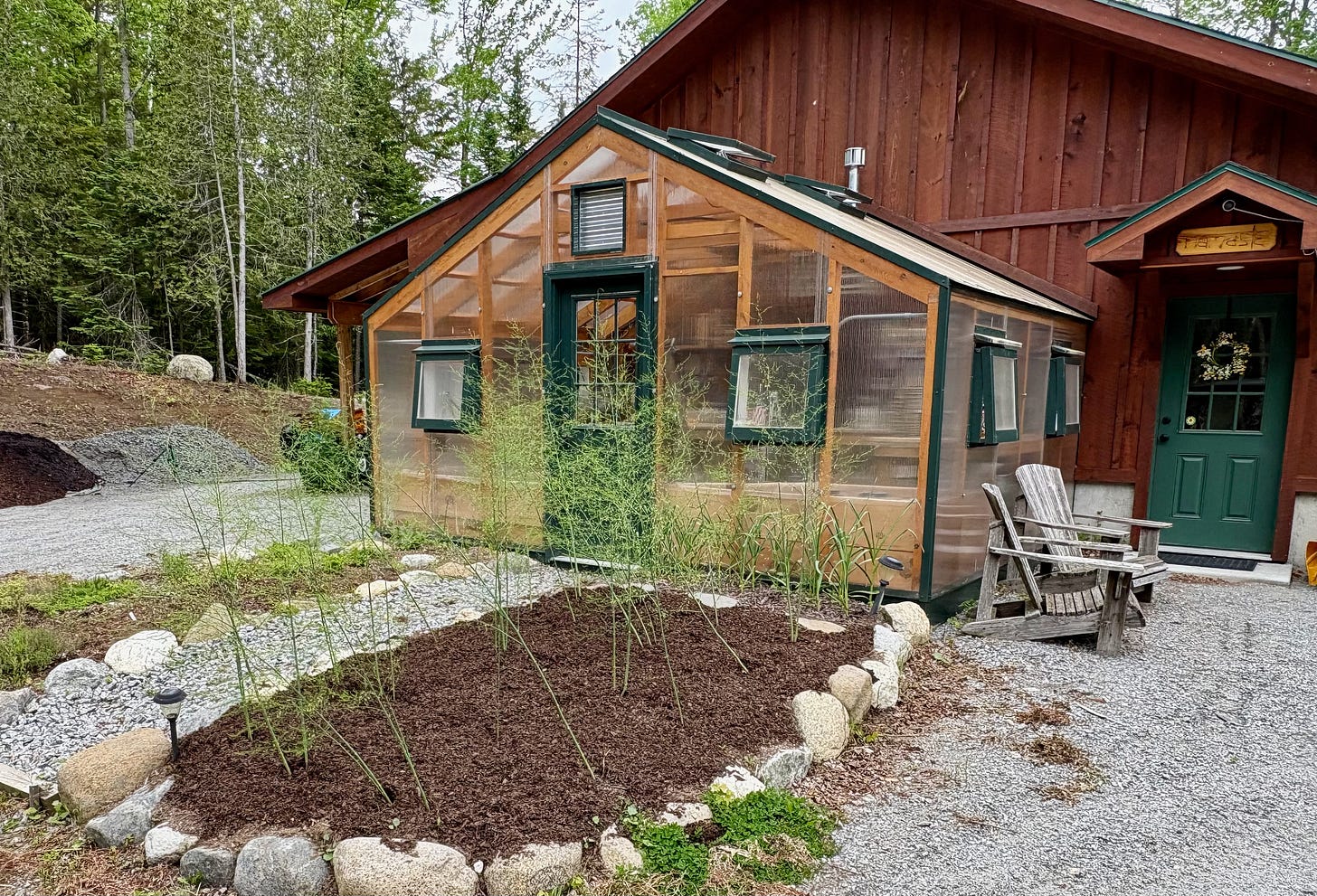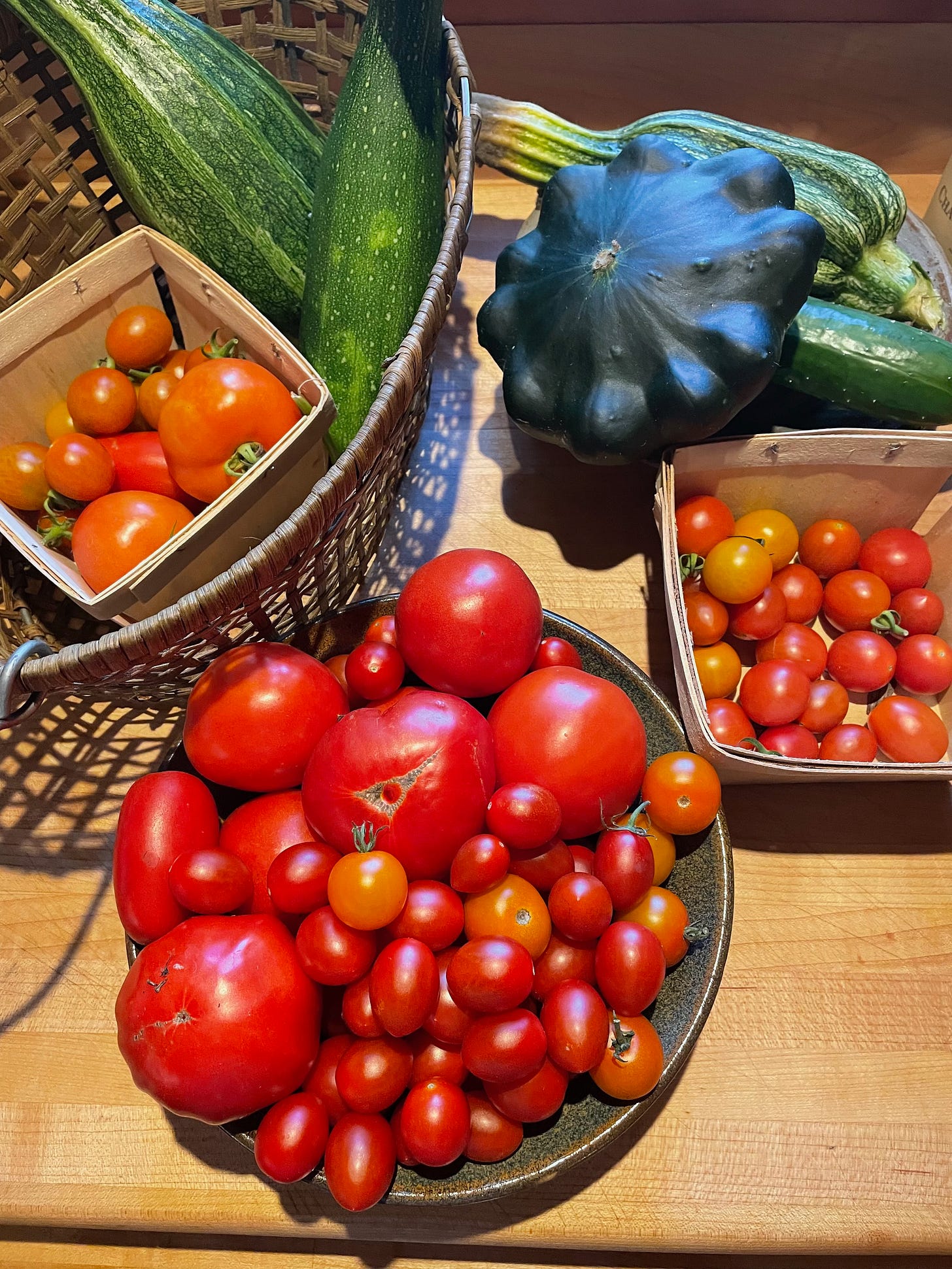June 21, 2025 - Vol. 29
When does a passion become an obsession?
It has been eighteen years since William Alexander penned his classic: “The $64 Tomato: How One Man Nearly Lost His Sanity, Spent a Fortune, and Endured an Existential Crisis in the Quest for the Perfect Garden.”
Alexander’s personal gardening treatise preceded another of the author’s culinary memoirs, “52 Loaves”, which chronicled the humorist’s fifty two weeks of adventure in search of the prefect sourdough boule and the traditional process of making said loaf. (There are monks in the story.) Our common midlife crises in baking and gardening clearly should have been cause for our paths to cross somewhere, most likely in a therapist’s waiting room, but I am sorry to say that I have never met this man whose pursuits and passions so closely parallel my own.
I am, on occasion, reminded of my appreciation for Alexander’s writing, and I was last week when a friend commented that the tomatoes growing in my garden this season must each be costing more than $64. Obviously, my neighbor was familiar with Alexander’s contribution to agricultural economics, and had been watching me fence in my new—four (more) raised bed—garden. If we count the purchase of a tractor in the calculation, $64 will be a layup. Since the $64 number was getting somewhat dated since the book’s printing, and having spent forty years in finance before retiring to my garden, I took it upon myself to calculate the inflation adjusted present value of Alexander’s $64 tomato. Factoring in an annual inflation rate of 2.5% over eighteen years, the cost in current dollars would be $99.82. Adding in an additional adjustment for the “Biden-Harris inflation surge of 2024” I think that we can call it an even $100.
A new addition this year. Deer proof? Fox proof? Time will tell. The planting bags on the work table are potatoes.
My appreciation for a good tomato predates the publication of “The $64 Tomato”. I am the only person you know who goes to Peter Luger’s Steakhouse for the side of beefsteak tomatoes. Some of my fondest memories have a tomato in the story. In days of yore, I worked at the Massapequa Howard Johnson’s restaurant on Sunrise Highway on Long Island. On many mornings a local retired couple came to the restaurant for breakfast, and over the years they got to know the staff very well. During the summer months they would bring in vegetables from their garden for the waitresses, including late summer beefsteak tomatoes that were the size of softballs, probably weighing close to two pounds. Their garden fertilizer “trick”, which they shared with me, was applying ground up fish scraps from the fish monger on Montauk Highway, which they poured into a trough alongside the rows of tomato plants by the barrel full. There are no bears on Long Island’s Great South Bay like we have here in the Adirondacks, where spreading barrels of fish scraps might not be a good idea. I did try a variation on this fertilizer theme, prompted by their delicious results.
I usually move my tomatoes outdoors around the first week of June, once nighttime temperatures are above fifty degrees. Some plants are started in March or April in my greenhouse. Some plants are purchased from the local garden nursery after the slugs eat the tomato plant seedlings in my greenhouse. (Author’s note: building a greenhouse makes it much, much easier to reach that $64 / $100 adjusted cost per tomato.) The first week of June is the very same time that the bluegills are schooling up along the shoreline of our pond to spawn, and it takes all of ten minutes to catch ten bluegills to fertilize ten tomato plants. I have read that Native American gardeners used a similar technique to plant the “three sisters” crop of beans, squash, and corn, placing a piece of fish at the base of each planting. So I tried it.
The first time I used this technique, the following morning I noticed small holes, three or four inches in diameter, dug in the soil alongside each of the tomato plants. The holes were dug neatly with exacting precision, next to each plant. The tomato plants were completely untouched, but every bluegill was gone. Anxious to figure out what was going on, I went back to the pond, caught a few more bluegills, buried the new fish under each of the tomato plants and placed a motion activated trail camera on a tree next to the raised beds. The fish caper was too neat and precise for the culprit to be a bear; they would just rip out the plants to get to the fish. I expected a racoon, or perhaps a bobcat or a marten to be the culprit. When I returned the next morning, the exact same scene greeted me. Holes next to each and every plant. No fish. I retrieved the memory card from the trail camera and using my laptop, displayed the pictures of a beautiful red fox, carefully digging under each plant to retrieve a fish dinner for her litter of kits somewhere nearby in the woods. I gave up on fertilizing with whole fish until I fenced in the garden the following year. The fox visited occasionally for years and became particularly fond of discarded stale sourdough bread that we put out for the birds.
The new asparagus bed in front of the greenhouse is in year two. Our first harvest will be in year three.
My gardening addiction has expanded far beyond the two small, raised beds that were the site of the fox fish caper. I think it is a natural transition for someone who likes to cook, which my wife and I both enjoy very much. A kitchen “herb garden” quickly expanded from one garden bed to two, which provide a constant supply of parsley and sage and yes, two rosemary plants and a bay (leaf) laurel bush and a pot of planted thyme, all of which move from the garden to the greenhouse to the kitchen window in winter. Fresh mint and lemon balm and dill and chives and fresh oregano are all steps from the kitchen door. Four new raised beds now supply lettuces and arugula and spinach and beets and Swiss chard. They are all supporting players, for the focus and raison d’etre of our gardening pursuits will always be tomatoes.
One day’s harvest from last summer.
I survived a decade of trying to raise “heirloom” tomatoes just so I could say that I did it. There is a reason that hybrids like Big Boy and Early Girl and Sun-Gold cherry tomatoes are so popular. They are resistant to diseases and are prolific producers. William Alexander is a big fan of Brandywine tomatoes, probably the most popular of the heirloom varieties. And extremely difficult to grow. They are admittedly delicious with a robust tomato flavor, but I can count on one hand the number of tomatoes that any Brandywine tomato plant has produced in my garden, and more often than not they succumb to some disease or fungus or bug before I get to pick a single fruit. It is easy to get to $64 per tomato when the denominator in the equation is 3 (tomatoes). So I “cheat” and focus on hybrid varieties that are prolific producers, all of which are delicious. Perhaps they are only 90% as delicious as a Brandywine, but I can live with that.
Anyone who suffers through a winter of hothouse tomatoes from Florida looks forward to the end of July and the peak of tomato season in August. In northern New York, August is for tomatoes, and the entire month is celebration of tomatoes in our kitchen, when every meal is accompanied by a tomato salad. On frequent occasion our meal is just a gigantic bowl of tomato salad, drizzled with a good extra virgin olive oil, along with a chiffonade of fresh basil leaves and perhaps a few crumbles of feta cheese. Use the good olive oil for this, not the ‘cooking” olive oil. We fell in love with a few producers some Portugal this winter and look forward to dressing our tomato salads with these newfound friends this summer. In Portugal we also found a typical service included very thinly sliced red onions in the salad, which was a wonderful addition. A simple tomato salad, dear reader, is as good as it gets and the reason that God made tomatoes.
When the days start to chill in late September my wife prepares for our annual exercise of “putting up” the cherry tomatoes which are still green and still hanging on the plants. This is a distinctly different exercise than “canning” ripe tomatoes for sauce. Pickled green cherry tomatoes are the absolutely perfect garnish for a well-made martini, and also serves as a reminder of what we are missing during the long dark nights of an Adirondak winter. They are the default accompaniment for a martini in our kitchen.
Why gardeners wear hats.
For the moment, we are in the blissful anticipation phase of an early garden. All of the plantings are in, including ten tomato plants. Spring’s first plantings of peas and lettuce and spinach are just about ready to harvest. It is too early for the squash leaves to turn yellow, or for the cucumbers to die for no apparent reason. Tomato hornworms have not found the raised beds, and there are no newly ripened, perfect tomatoes for chipmunks to take a single bite out of and then leave on the ground just to aggravate you. Daytime temperatures are a perfect 72 degrees, not hot enough for the lettuce to bolt, or the peas to wilt and fall over dead. It is early in the season—and everything is perfect, and as it should be.
Is your garden in yet?
Comments and suggestions are always welcome, as are Shares. If you like what you have read and you would like to receive a Saturday morning email with the current week’s Adirondack Diary update, please consider subscribing. All posts are public and available for free.
Join me on BlueSky @northcountryjoe.bsky.social









Wow! What a fun commentary! We never got into building greenhouses; we did have a couple of raised beds with mixed (very!) results. Finally, we decided our limited space here on the lake was not conducive to a garden, so we asked a semi-distant neighbor if we could use a small portion of their field. We spread wet newspaper to kill the weeds and covered it with beautiful, black topsoil trucked in from Ticonderoga.
It was a sometimes fun, almost always frustrating labor of love. We had a few good years and a couple of really not good ones and finally gave up. (It was actually the fact that we had to haul water in garbage barrels to the site because there was no water source there that was the straw that broke the camels back.)
So we now frequent the area’s farmer’s markets. Perhaps not as much fun, but the results are consistent-and the tomatoes are, I believe, less than $100 each……
I understand completely. I added two more raised beds, bought a yard of raised bed soil, 10 (64qt) bags of potting soil, and started with about $150 for Mr. Burpee. There are the usual Early Girls, Cherokee Purples, and Lemon Boys. But then I toss in some funky names, Gladiator, Atlas, Super Steakhouse. Usually just one plant of each, but they add up to 15 total. Add in the “never can resist” hot peppers and we have the beginnings of salsa. How does it expand? Can’t let the local growers go without. Hey, I’ve never tried that one! Wanted only two bell pepper plants, but they only came in 6 packs. Who throws out 4 pepper plants? Also just installed an irrigation system on the raised beds which can put out a gentle mist. Will it save money? No. But when the temperature hits 98 on Monday and Tuesday I can go stand in the tomatoes.